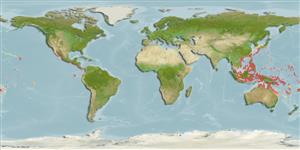>
Gobiiformes (Gobies) >
Gobiidae (Gobies) > Gobiinae
Etymology: Eviota: No etymology given, suggested by Christopher Scharpt: from Latin 'eu' for 'true' and 'iota' for anything very small, in combination 'truly very small' referring to it as being the smallest vertebrate at the time it has benn described by Jenkins (thus, making the suggestion by Scharpt plausible.
Environment: milieu / Zona climática / intervalo de profundidade / distribution range
Ecologia
marinhas associadas(os) a recifes. Tropical
Indo-Pacific: Japan, Micronesia (Palau and Yap), Hong Kong, northern Vietnam, Philippines, Indonesia (Java and Kalimantan to West Papua), and Western Australia.
Tamanho / Peso / Idade
Maturidade: Lm ? range ? - ? cm
Max length : 2.5 cm SL macho/indeterminado; (Ref. 48637)
Descrição suscinta
Chaves de identificação | Morfologia | Morfometria
Espinhos dorsais (total) : 7 - 8; Raios dorsais (total) : 8 - 9; Espinhos anais: 1; Raios anais : 7. Characterized by semi-translucent greyish body with internal stripe of alternating white and reddish brown; large brownish patch on lower side just posterior to pectoral fin base punctuated with large irregular white spots; from nape, along dorsal fin base, to dorsal surface of caudal peduncle with 14 brown spots/saddles; above anal fin base with 6-7 similar brown and white marks; first four dorsal spines of male and first two spines of female often elongate and filamentous; all pectoral rays unbranched; longitudinal scale series 22-23; ctenoid scales except on head, nape, breast and pectoral fin base; separated pelvic fins, bases joined by thin membrane; fourth pelvic ray with 2-8 branches; depth of body 4.0-4.5 in SL (Ref. 90102).
Body shape (shape guide): elongated.
Inhabits shallow inshore algal reefs (Ref. 48637).
Ciclo de vida ou comportamento de acasalamento
Maturidade | Reprodução | Desova | Ovos | Fecundidade | Larvas
Lachner, E.A. and S.J. Karnella, 1980. Fishes of the Indo-Pacific genus Eviota with descriptions of eight new species (Teleostei:Gobiidae). Smithson. Contrib. Zool. (315):127 p. (Ref. 5293)
Status na Lista Vermelha da UICN (Ref. 130435: Version 2025-1)
Ameaça para os humanos
Harmless
Uso pelos humanos
Ferramentas
Relatórios especiais
Baixar XML
Fontes da internet
Estimates based on models
Preferred temperature (Ref.
123201): 24.9 - 29.3, mean 28.6 °C (based on 1961 cells).
Índice de diversidade filogenética (Ref.
82804): PD
50 = 0.5000 [Uniqueness, from 0.5 = low to 2.0 = high].
Bayesian length-weight: a=0.00692 (0.00284 - 0.01683), b=3.10 (2.92 - 3.28), in cm total length, based on LWR estimates for this Genus-body shape (Ref.
93245).
Nível Trófico (Ref.
69278): 3.1 ±0.3 se; based on size and trophs of closest relatives
Resiliência (Ref.
120179): Elevada, tempo mínimo de duplicação da população menor que 15 meses (Preliminary K or Fecundity.).
Fishing Vulnerability (Ref.
59153): Low vulnerability (10 of 100).
🛈
Nutrients (Ref.
124155): Calcium = 409 [171, 1,195] mg/100g; Iron = 1.55 [0.66, 3.47] mg/100g; Protein = 17.6 [15.5, 19.5] %; Omega3 = 0.104 [0.035, 0.292] g/100g; Selenium = 31.8 [9.4, 94.2] μg/100g; VitaminA = 123 [24, 599] μg/100g; Zinc = 4.33 [2.38, 7.27] mg/100g (wet weight);
